Jerónimo Cosida facts for kids

Jerónimo Vicente Vallejo Cósida (born in 1510, died April 5, 1592) was a talented Spanish artist. He was a painter, sculptor, goldsmith, and architect during the exciting time of the Renaissance.
About Jerónimo Cósida
Jerónimo Cósida came from a noble family. He was especially good at painting large murals on walls and creating beautiful altarpieces. Altarpieces are decorated screens or panels placed behind the altar in a church. He made over twenty-five of these, though many are now lost.
He worked mostly in the area of Zaragoza, Spain. Cósida was very careful and detailed in his art, especially when painting women. He dedicated almost sixty years of his life to painting, showing how much he loved his work.
His Artistic Style
Jerónimo Cósida is known for bringing the artistic style of Raphael to Spain. Raphael was a famous Italian Renaissance painter. Cósida probably learned this style while training in Valencia with Vicente Masip, since he never traveled to Italy himself.
He was also influenced by the German artist Albrecht Dürer, especially in his drawings. Cósida was a great innovator and a pioneer of Renaissance painting in Aragon. Along with the Italian artist Tomás Peliguet, his style stands out for its:
- Careful details
- Elegant gestures and faces
- Stylish body shapes
- Complex arrangements in his paintings
Important Works
Cósida was an art advisor to Hernando de Aragón, who was the Archbishop of Zaragoza. The Archbishop was his main supporter, which allowed Cósida to work in the local Cathedral and have his own art workshop in the city.
One of his oldest surviving works includes some paintings and the Altarpiece of San Juan Bautista in Tarazona Cathedral, made around the 1530s. As he got older, his style changed. By the mid-1500s, he developed a style called mannerism. This style showed that he had learned from masters like Raphael and was inspired by Leonardo da Vinci.
A great example of his later work is the painting Birth of St. John the Baptist. This painting is part of the altarpiece at the Charterhouse of Aula Dei and was painted around 1580. It is considered one of his best pieces. Another work by Cósida, The Glorification of the Virgin, is part of a collection of European paintings.
See also
 In Spanish: Jerónimo Cósida para niños
In Spanish: Jerónimo Cósida para niños

